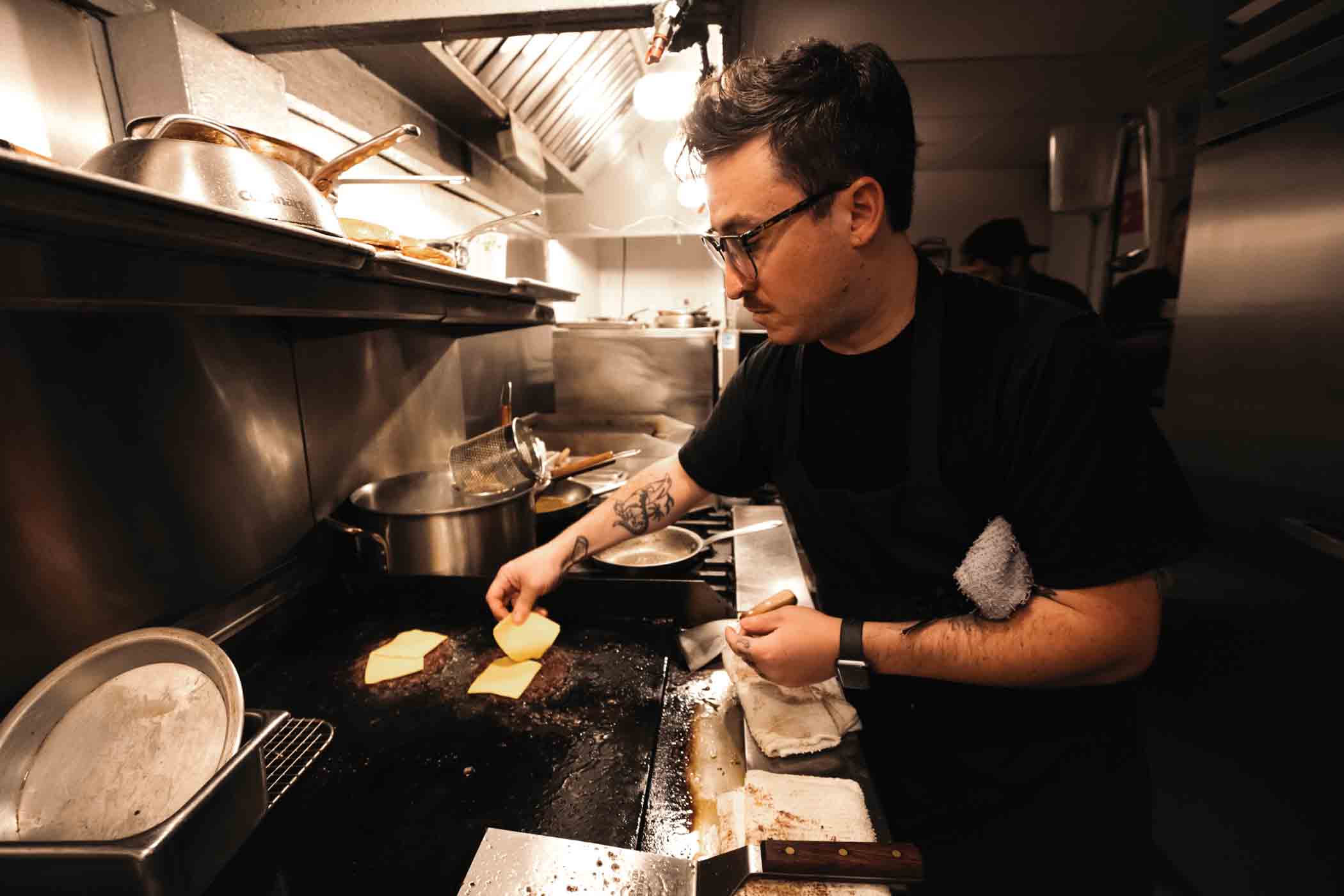WINED & DINED
By Peter Michael
Chefs and partners Mario Scavuzzo, David Koelling, and Jessen Koelling
By Peter Michael
Chefs and partners Mario Scavuzzo, David Koelling, and Jessen Koelling

Believe it or not, it was the spuds that made my knees buckle. A full When Harry Met Sally reaction. Raised eyebrows. Dramatic head twirls. And more purring from my side of the table than you’ll hear during a Broadway performance of the musical Cats.
Serve me a really tasty tater, and I’m putty in a chef ’s hands. Happens infrequently, but probably too often for my wife’s liking. The first time it happened was decades ago, in Las Vegas of all places. A server presented me with a bowl of Joël Robuchon’s signature pomme purée (aka, the silkiest mashed potatoes ever to grace a sauce pot), and I swooned like a teenager at a Taylor Swift concert.
My most recent potato epiphany occurred at Gigi Wine Bar & Bistro in Barrington. My wife had ordered Executive Chef Jessen Koelling’s 16-ounce wagyu ribeye. It’s one gorgeous hunk of tender meat. Sourced from a ranch in Texas. Marbled like the walls at Caesar’s Palace. Sprinkled with salt and pepper. And cooked to such a luscious plum-red color that it practically screams out for a juicy New World cabernet.

Leaning against the edge of the steak, however, sat its dark and crispy sidekick: one of the best potato pavés I’ve had in years. One bite and I was already wistful over the spud. May every French chef I’ve ever interviewed forgive me for what I’m about to type: a good pavé, at least for this meat-n-potatoes Chicagoan, is France’s dinnertime answer to an early-morning American hashbrown.
You run a potato against a mandolin, slicing it into thin scallop- shaped disks. The sliced potatoes are usually steeped in a cream sauce, then folded criss-cross, one by one, atop each other in a casserole bowl. Dribbles of cream are then poured over each layer until you have a Napoleon-like potato cake. After a bake in the oven, the resulting cake is sliced up like a pound cake and then fried until it’s developed a crispy second skin.
Koelling’s pavé omits the cream in favor of butter, garlic, and herbs. It’s cooked for over an hour, pressed, and then chilled overnight. When an order is placed during service, the edges are crisped, creating a crackly framework around an intensely pillowy center. Don’t leave Barrington without trying one—or a half dozen—of them.

When I was younger, potato pavés seemed to be everywhere, as ubiquitous as dense rounds of flourless chocolate cakes. But in recent years, I don’t see them—at least good pavés—as often. So whenever I cross paths with a classically trained chef, like Koelling, I become nostalgic for great meals long passed.
Gigi’s dinner menu invokes many such sentimental moments. When’s the last time, for instance, that you ordered butter-poached lobster and it arrived moated by not one but two sauces: a bisque-inspired creme and a lobster demi-glace?
If you’re a diner of a certain age, with a certain palate, you might get as dewy-eyed and nostalgic as I did. These days, most bistros are built, staged, and designed to look like some fogged-mirror myth of what Toulouse-Lautrec wanted Paris to look like in the late 19th century. That’s not exactly Gigi’s vibe. There are, of course, some classic French accouterments. The olive-green water bottles. Floral-patterned dishes festooned to the wainscotting. And accent walls covered in Gilded Age burgundy wallpaper. But it seems to be striving for an air of community and hominess instead of kitsch or haughtiness.

It’s trying to say something, rather than just impersonating a bucolic French bistro. The fact that the father-and-son team of David and Jessen Koelling have transformed Barrington’s iconic Bread Basket restaurant—a long-standing local coffee shop and breakfast spot that COVID-19 forced to shutter—is a triumph in itself. The footprint of the room, rectangular as a row house, feels like it was born to be a bistro. But the menu is undeniably pan-European. One might even argue that it’s pan-global.
The menu is flush with offerings— some entrees; others appetizer- sized—inspired by Chef Koelling’s picaresque culinary journey. Over the years, he’s cooked everywhere from Argentina to Japan with multiple stops in between. Thus the menu feels almost autobiographical, slipping in all sorts of unexpected delights.

Consider his artichoke agnolotti. It’s a sublime dish—note the way a farce of artichoke, aged Parmesan, and brioche generates an earthy flavor every bit the equal of a French truffle— inspired by time spent working in the kitchen at Locanda del Pilone in Northern Italy. And then there’s his mic drop of an Alsatian tart, which is crispy as a cracker crust pizza yet somehow manages to dial down the intensity of its bacon, onions, and fromage blanc into soft and downright gentle notes. Pair it with some bubbly and you’ll generate instant romance.
So, forget Paris. Vive la Barrington. Gigi not only serves tantalizing fare but also portals you back two decades to our recent culinary past. Back to the early 2000s, when salmon tartare wasn’t flat but stacked tall with rainbow- colored layers of salmon, guacamole, and sweet potato confetti.

There is a temptation, of course, to read too much into the fact that Koelling runs the restaurant with his father, a legend who helped put Chicago and the northern suburbs on the culinary map in the 1980s. In a sense, you can feel the individual passion of both father and son working in unison here. They seem to want to create something that honors the past while respecting the present. This feeling of culinary déjà vu is a blessing that raises the eyebrows, produces smiles, and makes even the pickiest of potato eaters purr with delight.
Gigi Wine Bar & Bistro is located at 131 Park Avenue in Barrington. Please call 847.926.7435 or visit gigiwinebarandbistro.com.
Sign Up for the JWC Media Email